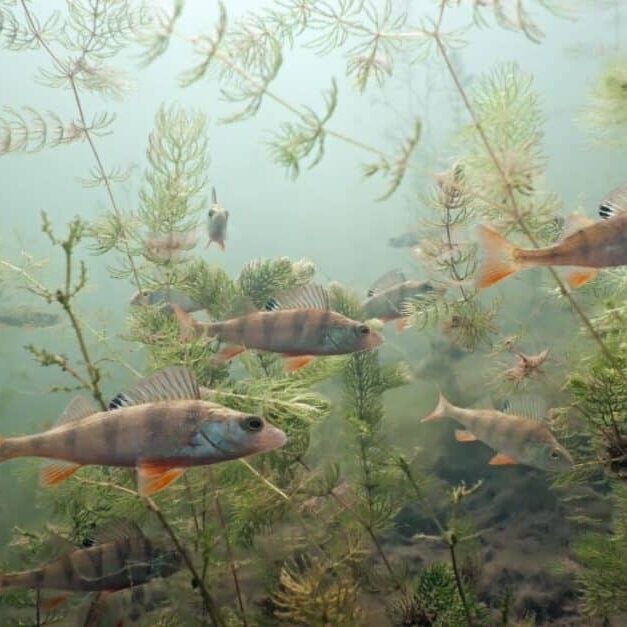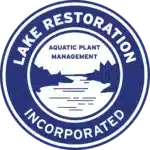
Is Pond Algaecide Safe for Fish?
What is an Algaecide?
Algaecide is defined as “a substance that kills or inhibits the growth of algae” (dictionary.com). The most widely used algaecides contain copper as the active ingredient. Copper binds with the algae cells, quickly killing them. Lake Restoration’s best-selling algaecide, Mizzen, is a liquid formulation of the most widely used algaecide, granular copper sulfate. An alternative algaecide has a different active ingredient: sodium percarbonate. This is the active ingredient in our Cape Furl algaecide, which is a granular option. Mizzen must be diluted with water and sprayed over algae; Cape Furl can be broadcast directly onto algae or dissolved in water then sprayed on the treatment area. Typically, Cape Furl is chosen when there are trout, koi, or channel catfish in a pond, as these fish have a sensitivity to copper. Applying an algaecide to nuisance algae growth is the most direct and effective means of pond algae control.
Fish Safe Algaecide
Many people ask if algaecides are safe for fish. Yes, algaecides are EPA approved, and can be used effectively to get rid of algae in a pond without harming fish. For most situations, the concern of a fish kill does not come from the algaecide itself, but from the depletion of oxygen when the algae dies off. Algae produce oxygen when they are growing and consume oxygen after they die. Oxygen depletion can be avoided by treating the pond in sections. For example, the Mizzen label states: “To minimize this hazard, do not treat more than half of the water body to avoid depletion of oxygen due to decaying vegetation. Wait at least 14 days between treatments.” By treating half the pond at a time at least two weeks apart, algae can be controlled while keeping enough oxygen in the water for fish.
While the largest concern with algaecides is oxygen depletion, it is important to read the “Environmental Hazards” section of the product label for the algaecide you want to apply. With copper-based algaecides, there is often a statement like the one on the Mizzen label: “This product is toxic to fish and aquatic invertebrates.” This statement is precautionary, and this product is not known to be directly toxic to most fish. As mentioned previously, trout, koi, and channel catfish have a sensitivity to copper. If any of these fish are present in a pond, Cape Furl is a great alternative to Mizzen. Cape Furl is not toxic to fish. It is important to understand that copper-based algaecides do pose toxicity to aquatic invertebrates such as snails, leeches, and mussels, especially when applied at high label rates. Depending on the purpose for using a copper-based algaecide, this can be an advantage or disadvantage.
Animal Safe Algaecide
Because copper is toxic to aquatic invertebrates at high label rates, people use Mizzen or copper sulfate to help prevent swimmer’s itch. Snails are often host to the microscopic parasites that cause swimmer’s itch. When an infected snail bed has been identified, copper sulfate can successfully be used to treat that area, killing off the infected snails. At lower label rates, copper algaecides are not harmful to wildlife. They do not have environmental hazards or livestock watering restrictions listed on the labels. Mizzen is safe for ducks, deer, and other animals swimming in and drinking the treated water.
Sodium percarbonate algaecide labels, like Cape Furl, mention that they are toxic to birds. When applied to water, the algaecides are quickly diluted. If birds bathe in or drink treated water immediately following application, they may experience mild irritation. After one day, the diluted algaecide has broken down enough to be completely safe for birds and other wildlife. Large-scale treatments of algae in lakes and ponds are done with sodium percarbonate algaecides without harming birds.
Which Algaecide should I Use?
Mizzen is Lake Restoration’s most popular algaecide. The copper-based formula is widely used to treat many types of algae. This broad-spectrum algaecide is fish safe if no more than half the pond is treated at a time and there are no trout, koi, or channel catfish present. Mizzen is also animal safe. It is easy to use by diluting with water and spraying directly onto algae. Mizzen, like other copper-based algaecides, is most effective in water temperatures of 60˚ F or warmer. Results are typically seen in seven to 14 days.
Cape Furl algaecide is made with sodium percarbonate, which is fish safe for all types, including trout, koi, and channel catfish. Users have the option of broadcasting the powder-like granules directly or dissolving in water then spraying onto algae. Although the label states that Cape Furl can be toxic to birds, the risk of harming birds is very low; Cape Furl is animal safe. Cape Furl and Mizzen are a safe and effective way to get rid of algae in a pond.
